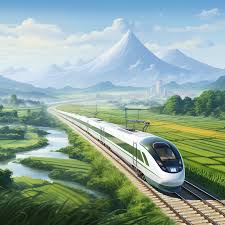In the contemporary world of soaring cities and emerging technologies, large-scale initiatives in High-Speed Rail Revolution (HSR) are reshaping the geography of mobility. These projects have set a goal to cut down on the travel time, increase economic development and improve the connection between different regions, making them an environmentally friendly solution to the transportation issue.
Major high-speed Rail Projects
The high-speed rail revolution is not merely a technical novelty but an agent of change in the economic and social realms. Many countries are actively implementing the idea of high-speed rail, and China is the most advanced country in this sphere. China has the longest network of HSR systems, covering over 38,000 kilometers of railway track. For instance, in the Beijing-Shanghai High-Speed Railway, which is among its key projects, it takes less than five hours to cover the distance between two important economic regions, boosting business and tourism. In Europe, the French TGV and the German ICE are the most developed providing comfortable traveling across Europe.

There is also Spain’s AVE high-speed rail network linking up Madrid with Barcelona and Seville, among other cities. On the other hand, we have the Japanese Shinkansen, the first high-speed rail service, with current trains going as fast as 320 km/h while stressing on safety and reliability. High-speed rail has multiple economic advantages. It fosters regional growth since it brings together cities, relocating citizens and products.
Scope
This results in lower travel times and improved work commutability which implies that employment opportunities are subsequently broadened. Also, thousands of construction and operation jobs are opened with HSR projects leading to a substantial contribution to the economy during the construction and after. In environmental aspect, high-speed rail travel is a sustainable form of transport as compared to car and air travel. New trains produce even lesser CO2 emissions per passenger kilometer than planes and cars. Furthermore, through the construction of HSR networks, traffic pressures on roads and at airports are mitigated, thus leading to decreased emissions, and enhanced quality of the environment. Electric trains, and especially those which are charged by renewable energy sources, add to the environmental advantage as well.
Technology advancement
We can note that high-speed rail technology has been progressing significantly in terms of its development. Magnetic levitation (maglev), a newer type, floats on magnets and are faster than other train types with speeds over 600 km/h and more comfortable rides. This comes in the wake of the advancement of technology in the construction of trams such as the Shanghai Maglev that has been in use since 2004. Progress in infrastructure technologies such as the design and type of tracks used in HSR systems have improved the sturdiness and reliability of the railway networks. Control and signaling structures and communication has also changed and integrated intelligent and automate systems for the train time-table and safety.
There are several challenges that high-speed rail has to deal with Though high-speed rail has numerous benefits, it has to deal with several challenges. The implementation of HSR infrastructure involves a considerable initial installation cost which can be measured in billions of monies. It is not usually easy to get the resources and political backing whereas sometimes it is very hard, specifically where the short term market imperatives prevail.

Challenges
There are also general problems such as the issue of getting access to land for development and issues to do with the environment. Infrastructure works involve extensive areas for construction hence the possible relocation of population and impacts on the natural environment. The problem of how to achieve sustainable development while protecting valued physical environments and respecting social justice is still one of the most vital. There are apparent effects when it comes to the speed of rail transport in as much as it concerns urban development and connections across different regions. HSR, in a way, create opportunities for the emergence of new economic landscapes and new complex of urbanized spaces.
This connectivity ensures that that regional development is enhanced and well distributed and this helps to avoid extreme concentration of larger cities while encouraging expansion of smaller cities and towns. Overall, it is also important to note that the advancement of high-speed rail is the leading cultural change in the transportation industry today. HSR project offers beneficial solution in the situation of contemporary transport by linking cities and economy, improving travel and contributing to economic development. With the advancement of technology and increased global interest, new applications and additional line connections will be created, making the high-speed rail network continue the unification of distances and the world.
Read also Commencement of Construction for high speed Rail Between Las Vegas and California

